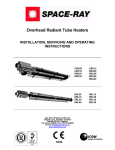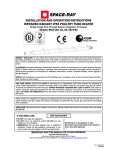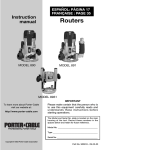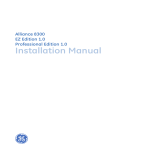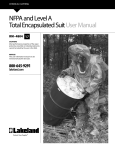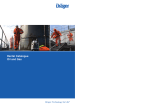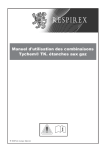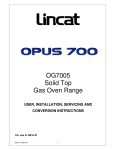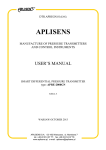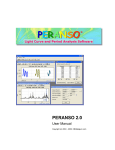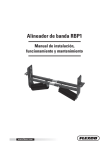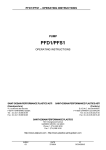Download ONESuit® Pro User Guide & Technical Manual - Saint
Transcript
Rev 4, Jan 2012 Page 1 of 17 Saint-Gobain Performance Plastics Ltd Bay 3, Transpennine Industrial Estate, Gorrels Way, Rochdale, OL11 2PX Tel: +44 1706 74 69 00, Fax: +44 1706 7469 91 Rev 4, Jan 2012 Page 2 of 17 Index Pages 2005-2006 Edition 1. Introduction to ONESuit® Pro 3 What is ONESuit®? Description of materials Compliance statements Options and Accessories 2. User Guide 5 A. Pre-Use Information Safety considerations Limitations of use Marking restrictions Explanation of symbols used Shelf life and usable life Visor anti-fog procedure Recommended undergarments B. Preparation for Use Sizing Pre Use Inspection C. Donning/Doffing Information Donning and doffing procedures Recommended storage and transportation D. Maintenance Information Maintenance and pressure test details Glove replacement procedure Decontamination procedures Retirement and disposal criteria 6 7 8 3. EN 943-1 and EN 943-2 Test Data 11 4. Chemical Test Data 11 5. NFPA 1991, 2005 Edition & NFPA 1994, 2007 Edition Test Data 12 6. Specific guidelines for ONESuit® Pro CBRN 13 7. Specific guidelines for ONESuit® Pro Industrial 14 8. Cleaning instructions and precautions 15 9. Inspection Log 16 10. Warranty & Disclaimers 17 Saint-Gobain Performance Plastics Ltd Bay 3, Transpennine Industrial Estate, Gorrels Way, Rochdale, OL11 2PX Tel: +44 1706 74 69 00, Fax: +44 1706 7469 91 Rev 4, Jan 2012 Page 3 of 17 SECTION 1: Introduction to ONESuit® Pro ONESuit® Pro is a gas-tight, totally encapsulating, chemical and biological protective suit ensemble that provides maximum protection at an affordable price. It is designed to meet the real-world needs of those who work in the most dangerous environments. ONESuit® Pro is CE-marked and has EC type approval from BSI in UK (CE0086) in accordance with the Council Directive 9/686/EEC on personal protective equipment and the relevant standards. ONESuit Pro ET also has been certified for maritime use with SOLAS II.2 approval as per the International Maritime Organisation (IMO) Equipment Directive. ONESuit® Pro is offered in 3 versions as follows: ONESuit® Pro ET (Emergency Team) ONESuit® Pro CBRN ONESuit® Pro Industrial This User Guide will focus firstly on the ET version and then cover key differences for other versions in sections 6 and 7. ONESuit® Pro ET (Emergency Team) offers: • • • • • • • • • • Certification and Testing to EN 943-1, EN943-2 , NFPA 1991 and NFPA 1994 Class 2 Protection from exposure to chemical/biological agents and industrial chemicals in both liquid and vapour form suitable for use by Emergency Teams and other HAZMAT responders. Flame and abrasion resistance without additional layers User-comfort due to conformable, light-weight, flexible fabric membrane Simple donning and doffing Ease of storage and handling due to compressible design Rigid cuff, tool less glove connection Integral sock or clamped detachable boot system Internal belting system that secures the suit to the body for increased mobility Enlarged ‘hump’ area to accommodate larger SCBA systems Description of materials & construction ONESuit® Pro uses only materials that have passed the most rigorous testing. • Garment Material Garment barrier fabric is Coretech™ UniGuard which is manufactured using proprietary fluoropolymer films and manufacturing processes by Saint-Gobain Performance Plastics. • Visor Material The visor is constructed of 3 integrated layers, Primary (inner) and Secondary (outer). The primary visor is made of FEP, and provides full chemical/biological agent protection. The secondary visor layers are made of flexible PVC. • Gloves Gloves are attached using a rigid cuff system providing a unique, tool less, strong securing mechanism A set of 2 gloves (inner and outer) complying with EN 374 are supplied on the suit. The outer glove on ET suit is a Comasec Butyl R 0,7 and the standard size is 10 with other sizes on request The inner gloves are also compliant with EN 374. The default option is Ansell Barrier size 10. • Closure The closure consists of a vapour-tight zip with garment material double splash flaps that seal using hook-and-loop fastener strips. The zip is installed for front entry; a 1220mm opening is created when the zip is open. o Tape and pull Material: PVC coated polyester o Slider Material: Aluminium Bronze o Chain Material: Nickel Silver Saint-Gobain Performance Plastics Ltd Bay 3, Transpennine Industrial Estate, Gorrels Way, Rochdale, OL11 2PX Tel: +44 1706 74 69 00, Fax: +44 1706 7469 91 Rev 4, Jan 2012 Page 4 of 17 • Attachments All garment seams are stitch less. They are produced by heat welding, and then covered outside with seam tape, or using RF welding for attachments. Visor seam is stitched to the garment material, and then seam taped with Coretech™ UniGuard each side. Gloves are attached using the rigid cuff system Zip is stitched to the garment material, and then seam taped with Coretech™ UniGuard each side. • Exhaust Valves The suit is equipped with 2 exhaust valves. These are maintenance-free, tamper-proof units with a design life well in excess of the anticipated suit shelf life. They are attached to the suit using a plastic nut, 2 rubber washers and 1 metal washer. The valve body is made from impact resistant plastic and the pressure demand diaphragm is made from silicone rubber and requires no routine replacement during the life of the suit. The valves are covered by flaps made from garment material and are complete with a pop stud to ensure correct orientation. • Pass-thrus or airlines: The suit is available with optional SCBA pass-thru assemblies installed upon customer request. These pass-thru (airline) assemblies include the following SCBA manufacturers: • Dräger • Interspiro • ISI • MSA • Scott Refer to the manufacturer for information on a specific pass-thru. • Protective Helmet The hood of this suit is designed to be worn with a protective helmet. • Boots The ET version must be worn with boots complying with EN 345-2, Type FPA and Etche Fireman SA boots are supplied on suits with attached boots instead of integrated socks. Compliance statement • ONESuit® Pro ET Protective clothing for use against liquid and gaseous chemicals, including liquid aerosols and solid particles, EN 943-2, Type 1a ET, Limited Use. It comprises of: ONESuit® Pro ET Comasec Butyl R 0.7 outer gloves Ansell Barrier Internal gloves Etche Fireman SA or customer supplied boot to EN 345-2, Type FPA Rigid cuff, tool less glove interface Integral sock or attached boots with clamp ring Options and Accessories Attachment points and Lifeline loops Pass thrus (airlines) Clamped boots Pressure tester kit Adaptor kit for pressure tester Stackable container Training suit Saint-Gobain Performance Plastics Ltd Bay 3, Transpennine Industrial Estate, Gorrels Way, Rochdale, OL11 2PX Tel: +44 1706 74 69 00, Fax: +44 1706 7469 91 Rev 4, Jan 2012 Page 5 of 17 • SECTION 2A: User Guide Pre-Use Information Safety considerations It is important that the user ensure that the suit is in clear plastic packaging with pressure test details and in good physical condition prior to use. If previously used but not contaminated, the suit must be inspected, pressure tested and packed in clear plastic bag, prior to being returned to service. Users must read this guide thoroughly, and should take the following precautions into consideration: 1. Avoid direct flame contact. The suit is not intended for use in an open flame. 2. Avoid continuous exposure to any known hazardous substance. Do not purposely expose the suit to a constant liquid/vapour hazard. 3. If the following symptoms are experienced, the user MUST leave the hazardous area: fever, nausea, dizziness, eye irritation, breathing difficulty, excessive fatigue, or any unusual odour or taste. 4. If it is suspected that this product has come into contact with a hazardous substance, follow appropriate departmental procedures for decontamination and disposal. NOTE: Most performance properties of this vapour protective ensemble or individual elements cannot be tested by the user in the field. Limitations of use • ONESuit® Pro ET The suit must only be used by trained personnel The suit must only be used with an SCBA complying with EN 137 for ET Air supplied through a pass-thru or airline must be of breathing quality Do not use with oxygen or an oxygen enriched air supply Ensure that the suit is removed prior to stopping the breathing air supply Must only be used with gloves approved to EN 374-1 Separate boots complying with EN 345-2, Type FPA or equivalent must be worn over the integral socks or clamped to the suit legs Limited use chemical protective clothing i.e. to be worn until contamination has occurred and disposal is required Marking restrictions It is recommended that this product not be marked by the user using permanent markers or ball point pens. While these inks might mark the product very well, it will have a tendency to smudge and transfer to other areas of the suit during storage. If marking is desired, please specify during the ordering process for permanent attachment of letters or numbers by the manufacturer. Explanation of symbols used Read Instructions Nuclear particulate contamination Chemical Hazards Microorganism Hazards Saint-Gobain Performance Plastics Ltd Bay 3, Transpennine Industrial Estate, Gorrels Way, Rochdale, OL11 2PX Tel: +44 1706 74 69 00, Fax: +44 1706 7469 91 Rev 4, Jan 2012 Page 6 of 17 Shelf life Based on our experience and available knowledge, Saint-Gobain Performance Plastics expects a shelf life of 10 years based on the specified storage conditions, maintenance, and testing practices. There is no need to dispose of the suits based strictly on time but if the SUIT has exceeded the 10 year period since date of manufacture, it is recommended to return the suit for annual inspection by the manufacturer or his representative. Limited use suits must be inspected and pressure-tested before being re-used if the suit has been used at an incident or fully removed from the original plastic bag but not contaminated. Once the suit is removed from the original packaging, the suit should be subjected to an annual inspection and pressure test. After the inspection and pressure test, the suit should be packaged again in a clear plastic bag with the original test date and date of re-inspection clearly marked in the Inspection Log (see page 9). If there is any question about the condition of the suit or any apparent damage, discontinue use immediately. It should only be returned to service if visual inspection, leak and pressure testing have been satisfactorily completed. Visor anti-fog procedure Anti-fog protection is not applied to the visor by the manufacturer. Commercially available anti-fog solutions suitable for soft plastics may be used on the inside of the visor. If fogging is likely to occur, be sure to have access to a clean, soft cloth that may be used to wipe the inside of the visor. Recommended undergarments The ONESuit® Pro is a fully-encapsulating garment and there is very little exchange of heat between the body and the outside of suit. The most appropriate garments will depend on temperatures outside the suit and mobility demands of the task. Certain synthetic and/or natural fabrics against the skin will aid in comfort by moving moisture away from the body. SECTION 2B: User Guide Preparation for Use Sizing ONESuit® Pro has been sized to fit a wide range of users. Please refer to the following table to assist in finding the appropriate size. NOTE: This size data does not include a person wearing a helmet, SCBA, or any other equipment. Suit Size Height (mm) Waist (mm) Recommended Boot Size (EU) Small Medium Large X-Large XX-Large 1525-1625 1625-1725 1725-1830 1830-1930 1880-1980 765-9407 940-1120 1120-1195 1195-1250 1250-1320 38-41 41-43 41-44 42-46 43-48 Saint-Gobain Performance Plastics Ltd Bay 3, Transpennine Industrial Estate, Gorrels Way, Rochdale, OL11 2PX Tel: +44 1706 74 69 00, Fax: +44 1706 7469 91 Rev 4, Jan 2012 Page 7 of 17 Pre Use Inspection Check the following before each use: Garment identification number is clearly legible Garment has been stored correctly Material is not discoloured or brittle Material is free from tears and holes (carefully check full length of seams) Garment is free from contamination inside and out Zip operates properly Arm and leg terminations are in good condition Gloves are correctly fitted Valves are present and correctly fitted Vision through visor is clear and not obstructed by marks or large scratches Report any defects to supervisor and record on Inspection Log sheet The garment must not be used until any defects have been rectified SECTION 2C: User Guide Donning/Doffing Information Donning and doffing procedures The ONESuit® Pro is designed to allow it to be donned and doffed with ease. • • • • Refer to the sizing section to determine the appropriate size suit. Be sure that the selected suit has passed inspection and pressure tests as required. It is recommended that a person be available to assist during the don and doff process. Be sure that there are no items on the body or clothing that could cause damage to the inside of the suit, such as rings, watches, badges, belts, etc. NOTE: When donning and doffing the suit, take care to avoid creasing the visor, as this could impair visibility and/or create a leak failure in the suit. To don the suit: 1. Choose a location that offers a clean place to stand and has either a bench or chair. 2. While seated, place both legs into the suit with only socks over the feet. Insert feet into boots. 3. Stand up, and while suit is at waist level, put SCBA pack on. It is recommended that the mask not be put on the face until the suit is ready to be zipped up in order to conserve air. Attach the internal belt to the waist, securing tightly to the body. 4. Put mask on face and turn on air supply. Put safety helmet on if required. 5. Pull suit over the head, being careful not to crease or crush the visor. 6. Zip suit completely closed, then close flap over zip. To doff the suit: 1. Follow the reverse order for donning the suit. 2. Special attention is required when withdrawing the hand whilst using an inner glove to prevent the fingers of the inner glove being pulled out of the fingers of the outer glove, which will make subsequent fitting more difficult. 3. Grip the ends of the fingers and thumb with the opposite hand pinching together the inner and outer glove finger ends before attempting to pull the fingers out of the glove. 4. If the inner glove becomes detached and it is not possible to re-insert the hand, the glove system should be disassembled and refitted as explained in Glove Replacement section on page 9. Recommended storage and transportation The ONESuit® Pro should be stored in a safe and dry location, away from direct sunlight with temperature maintained between -5ºC and 50ºC. The suit may be stored either in the supplied storage bag, stackable container or on a hanger, and should always be stored with the zip in the fully open position. The suit should be transported in the original supplied storage bag or stackable container. Saint-Gobain Performance Plastics Ltd Bay 3, Transpennine Industrial Estate, Gorrels Way, Rochdale, OL11 2PX Tel: +44 1706 74 69 00, Fax: +44 1706 7469 91 Rev 4, Jan 2012 Page 8 of 17 NOTES: Use caution when folding and handling the suit to avoid creasing the visor, as this could impair visibility and/or create a leak failure in the suit. If pass-thru or airline is fitted, protect the pass-thru with a cushioning material when folding. SECTION 2D: User Guide Maintenance Information Maintenance and pressure test details If Limited Use suits for Emergency Teams (EN943-2 ET) have been used at an incident but not contaminated or unpacked for any reason, a pressure test must be carried out in accordance with EN464 prior to repacking and storage, to be ready for immediate use. Use the following steps to pressure test the suit: 1. Remove the exhaust valves (quantity 2). 2. Install the pressure test adapters (sold separately) in the valve holes, with the hose connections facing outside of the suit. 3. Close zipper to the fully sealed position. Commercially available pressure test kits capable of testing to EN464 may be used to test ONESuit® Pro. Refer to the applicable pressure test kit operating instructions before proceeding. 4. Inflate the suit to a pressure of 1,750 Pa (17.5mbar or 178mm/7 inches of water column). Remove any creases and folds in the suit as far as practicable. 5. Lower the pressure to 1,700Pa (17mbar or 173mm/6.8 inches of water column) using the valve on the adapter. This is the pre-test expansion pressure and this pressure should be maintained for 10 minutes adding air if necessary 6. Adjust pressure to 1,650Pa (16.5 mbar or 168mm/6.6 inches of water column) and shut off air flow. This is the test pressure. Set and start the timer and wait for 6 minutes. Note the pressure at end of these 6 minutes. The suit should not be touched or moved during this period of time as this may lead to false results. The suit has passed the test requirements if the final pressure at end of 6 minutes is 1,350Pa or more (13.5 mbar or 138mm/5.4 inches of water column). 7. Record test results on the inspection log found in Section 9 of this guide. NOTE: Use caution when inspecting and pressure testing the suit to avoid creasing the visor, as this could impair visibility and/or create a leak failure in the suit. CONTACT SAINT-GOBAIN PERFORMANCE PLASTICS IF THE SUIT FAILS PRESSURE TEST. IT IS POSSIBLE THAT THE SUIT CAN BE RETURNED FOR REPAIR. NOTE: ANY RETURNED SUIT MUST BE ACCOMPANIED BY COMPLETED CERTIFICATE OF DECONTAMINATION OR CONFRIMATION NOTE THAT SUIT HAS NOT BEEN EXPOSED AT A CHEMICAL INCIDENT. Glove replacement procedure (Rigid Cuff) 1. Ensure inner glove has adhesive pads attached. These are fitted to the back of the fingers. Fit inner glove (if used) over full length of rigid cuff with largest diameter groove of cuff furthest from fingers of glove, so that approximately 40 mm of the glove gauntlet is overhanging the cuff. Tape glove in place over largest diameter groove to secure. Saint-Gobain Performance Plastics Ltd Bay 3, Transpennine Industrial Estate, Gorrels Way, Rochdale, OL11 2PX Tel: +44 1706 74 69 00, Fax: +44 1706 7469 91 Rev 4, Jan 2012 Page 9 of 17 2. Remove the backing to expose the sticky surface of the foam pad. Insert hand into the inner glove and then pull the outer glove over the inner glove. Squeeze each finger in turn to ensure the outer glove is secured to the inner glove in the correct position. Pull the remainder of the outer glove over inner glove and rigid cuff until top of glove sits in largest groove on cuff. 3. Pull sealing wrist band over outer glove and up onto cuff until the edge of the wrist band locates just over the edge of the widest part of the cuff. Pass glove assembly down inside corresponding sleeve. The sleeve seam should be centred on the little finger of the glove. Fit “O” ring welded into garment sleeve end over cuff, locating it in smallest diameter cuff groove. 4. 5. 6. Remove any creases from material and flip the sealing band back over the end of the suit sleeve removing any folds or creases from the sealing band. Place security “O” ring over the sealing band onto second groove of rigid cuff. Saint-Gobain Performance Plastics Ltd Bay 3, Transpennine Industrial Estate, Gorrels Way, Rochdale, OL11 2PX Tel: +44 1706 74 69 00, Fax: +44 1706 7469 91 Rev 4, Jan 2012 Page 10 of 17 Sealing Band Rigid Cuff Sealing band Decontamination procedures Limited Use ONESuit® Pro ET suits should be discarded after contamination by hazardous materials in accordance with departmental procedures for decontamination practices. Retirement and disposal criteria Refer to departmental procedures for disposal practices and procedures for this suit. All suits should be disposed of in accordance with current environmental regulations. Saint-Gobain Performance Plastics Ltd Bay 3, Transpennine Industrial Estate, Gorrels Way, Rochdale, OL11 2PX Tel: +44 1706 74 69 00, Fax: +44 1706 7469 91 Rev 4, Jan 2012 Page 11 of 17 SECTION 3: EN 943-1 and 943-2 Test Data PHYSICAL PROPERTIES AND GARMENT TESTS EN 943-1, Reusable Property Abrasion Flex cracking Trapezoid tear Tensile strength Puncture Seam strength Strength of detachable parts/attachments Exhaust valve max pressure change from -1 kPa in 1 min Max internal pressure @300 l/min Method EN 530 meth 2 ISO 7854 meth B ISO 9073-4 ISO 13934-1 EN 863 ISO 13935-2, A.2 EN 943-1,6.5 Requirement/Class >500 cycles/3 >15,000 cycles/4 >40 N/3 250 N/4 >10 N/2 >300 N/5 ≥100 N Result/Class >2000 cycles/6 >15,000 cycles/4 80 N/4 608.8 N/5 54.7 N/3 592.3 N/5 >100 N EN 943-1,6.6 ≥100 Pa Pass EN 943-1,6.4 ≤400 Pa Pass PHYSICAL PROPERTIES AND GARMENT TESTS EN 943-2, Limited Use Property Abrasion Flex cracking Flex cracking -30 deg C Trapezoid tear Tensile strength Puncture Ignition Seam strength Strength of detachable parts/attachments Strength of lifeline Strength of attachment points Pass-through strength Exhaust valve max pressure change from -1 kPa in 1 min Exhaust valve pull test Max internal pressure @300 l/min Method EN 530 meth 2 ISO 7854 meth B ISO 7854 meth B @ -30 ISO 9073-4 ISO 13934-1 EN 863 EN 13274-4 meth 3 ISO 13935-2, A.2 EN 943-1,6.5 Requirement/Class >1000 cycles/4 >1000 cycles/1 >200 cycles/2 >40 N/3 250 N/4 >10 N/2 Pass-through flame 1 sec/1 >300 N/5 ≥100 N Result/Class >2000 cycles/6 >15,000 cycles/4 >200 cycles/2 80 N/4 608.8 N/5 54.7 N/3 5 sec flame/3 592.3 N/5 >100 N EN 270:1994, 7.10 EN 270:1994, 7.10 EN 270:1994, 7.10 EN 943-1,6.6 ≥1000 N ≥250 N ≥1000 N ≤100 Pa >1000 N >250 N >1000 N Pass EN 943-1,6.5 EN 943-1,6.4 ≥150 N ≤400 Pa <150 N Pass SECTION 4: CHEMICAL TEST DATA Chemical/Agent Acetone Acetonitrile Ammonia 1,3-Butadiene Carbon Disulphide Chlorine Dichloromethane Diethyl amine Dimethyl Formamide Ethyl Acetate Ethylene Oxide Heptane Hexane Hydrogen Chloride Methanol Methyl Chloride Nitrobenzene Sodium Hydroxide Sulphuric Acid Tetrachloroethylene Tetrahydrofuran Toluene Cyanogen Chloride (CK) Carbonyl Chloride (CG) Hydrogen Cyanide (HCN) Dimethyl Sulphate Sarin (GB) Distilled Mustard (HD) Test Method ASTM F739/EN374-3 ASTM F739/EN374-3 ASTM F739/EN374-3 ASTM F739/EN374-3 ASTM F739/EN374-3 ASTM F739/EN374-3 ASTM F739/EN374-3 ASTM F739/EN374-3 ASTM F739/EN374-3 ASTM F739/EN374-3 ASTM F739/EN374-3 EN374-3 ASTM F739/EN374-3 ASTM F739/EN374-3 ASTM F739/EN374-3 ASTM F739/EN374-3 ASTM F739/EN374-3 ASTM F739/EN374-3 ASTM F739/EN374-3 ASTM F739/EN374-3 ASTM F739/EN374-3 ASTM F739/EN374-3 ASTM F739 ASTM F739 ASTM F739 Garment material >480 >480 >480 >480 >480 310 >480 >480 >480 >480 >480 >480 >480 >480 >480 >480 >480 >480 >480 >480 >480 >480 >60 >60 >60 Visor Material >480 >480 >480 >480 >480 >480 >480 >480 >480 >480 >480 >480 >480 >480 >480 >480 >480 >480 >480 >480 >480 >480 >480 >480 >480 Visor Seam >480 >480 >480 >480 >480 >480 >480 >480 >480 >480 >480 >480 >480 >480 >480 >480 >480 >480 >480 >480 >480 >480 >60 >60 >60 Garment Seam >480 >480 >480 >480 >480 >480 >480 >480 >480 >480 >480 >480 >480 >480 >480 >480 >480 >480 >480 >480 >480 >480 >60 >60 >60 ASTM F739 <0 .125 µg/cm2 after 1 hr < 4.0 µg/cm2 after 1 hr >480 0.001 0.023 >480 <0.001 <0.001 >480 <0.001 <0.001 >480 0.001 0.003 2 Saint-Gobain Performance Plastics Ltd Bay 3, Transpennine Industrial Estate, Gorrels Way, Rochdale, OL11 2PX Tel: +44 1706 74 69 00, Fax: +44 1706 7469 91 Rev 4, Jan 2012 Page 12 of 17 SECTION 5: NFPA Test Data PHYSICAL PROPERTIES AND GARMENT TESTS NFPA 1991(2005 Edition) Property Liquid Tight Integrity Ending Suit Pressure Accommodates Head protection Visual Acuity Remove/Reinsert Hands Maximum Suit Ventilation Rate Gas Tight Integrity Exhaust Valve Mounting Strength Fitting Pull Out Strength (Dräger Pass-through) Fitting Pull Out Strength (Interspiro Pass-through) Fitting Pull Out Strength (ISI Pass-through) Fitting Pull Out Strength (MSA Pass-through) Fitting Pull Out Strength (MSA Quick fill Pass-through) Fitting Pull Out Strength (Survivair Pass-through) Fitting Pull Out Strength (Scott Pass-through) Exhaust Valve Inward Leakage Flammability Resistance After flame – Garment Material Flammability Resistance Char Length – Garment Material Flammability Resistance No Melt or Drip – Garment Material Burst Strength – Garment Material Puncture propagation Tear Resistance – Garment Material Cold Temperature Performance – Garment Material Seam Breaking Strength – Garment Closure Breaking Strength Flammability Resistance After flame – Visor Material Flammability Resistance Char Length – Visor Material Flammability Resistance No Melt or Drip – Visor Material Cold Temperature Performance – Visor Material Method NFPA 1991 8.3 NFPA 8.4 NFPA 8.4 NFPA 8.4 NFPA 8.4 NFPA 8.5 ASTM F1052 NFPA 8.9 NFPA 8.13 NFPA 8.13 NFPA 8.13 NFPA 8.13 NFPA 8.13 NFPA 8.13 NFPA 8.13 NFPA 8.26 ASTM F1358 ASTM F1358 ASTM F1358 ASTM D751 ASTM D2582 NFPA 8.12 ASTM D751 ASTM D751 ASTM F1358 ASTM F1358 ASTM F1358 NFPA 8.12 Seam Breaking Strength – Visor Burst Strength – Visor Material Puncture propagation Tear Resistance – Visor Material Inward Leakage ASTM D751 ASTM D751 ASTM D2582 NFPA 8.8 Requirement No penetration ≥80 mm H2O Yes ≥20/35 5 times ≤100 mm H2O ≥80 mm H2O > 135 N > 1000 N > 1000 N > 1000 N > 1000 N > 1000 N > 1000 N > 1000 N ≤30 ml/min ≤10 seconds ≤100 mm Up to 12 seconds > 200 N > 49 N ≤0.057 Nm > 2.88 kN/m > 2.88 kN/m ≤10 seconds ≤100 mm Up to 12 seconds No Crack or Visible Damage > 2.88 kN/m > 200 N > 49 N 0.02% Result Pass 86.4 Pass 20/20 Pass 50.8 88.9 449 1996 1213 1724 2124 1172 1829 1731 9.5 0.0 63.5 Pass 774 106 0.009 12.8 7.065 3.82 20.32 Pass Pass 12.16 893 > 923.5 Pass NFPA 1994-2007 Edition Test Data PHYSICAL PROPERTIES AND GARMENT TESTS NFPA 1994 Class 2 (2007 Edition) Property Man-in-simulant Test Accommodates Head protection Visual Acuity Liquid Tight Integrity Fitting Pull Out Strength (Dräger Pass-through) Fitting Pull Out Strength (Interspiro Pass-through) Fitting Pull Out Strength (ISI Pass-through) Fitting Pull Out Strength (MSA Pass-through) Fitting Pull Out Strength (MSA Quick fill Pass-through) Fitting Pull Out Strength (Survivair Pass-through) Fitting Pull Out Strength (Scott Pass-through) Exhaust Valve Mounting Strength Exhaust Valve Inward Leakage Burst Strength – Garment Material Puncture propagation Tear Resistance – Garment Material Cold Temperature Performance – Garment Material Seam Breaking Strength – Garment Closure Breaking Strength Viral Penetration Resistance – Garment Material Viral Penetration Resistance – Garment Seam Burst Strength – Visor Material Puncture propagation Tear Resistance – Visor Material Cold Temperature Performance – Visor Material Method TOP-10-2-2022 NFPA 1994 8.3 NFPA 8.3 NFPA 8.3 NFPA 8.6 NFPA 8.6 NFPA 8.6 NFPA 8.6 NFPA 8.6 NFPA 8.6 NFPA 8.6 NFPA 8.24 NFPA 8.25 ASTM D751 ASTM D2582 NFPA 8.11 ASTM D751 ASTM D751 NFPA 7.1.2.7 NFPA 7.1.2.7 ASTM D751 ASTM D2582 NFPA 8.11 Seam Breaking Strength – Visor Viral Penetration Resistance – Visor Material Viral Penetration Resistance – Visor Seam ASTM D751 NFPA 7.1.2.7 NFPA 7.1.2.7 Requirement PPDF>361 Yes ≥20/35 No penetration > 1000 N > 1000 N > 1000 N > 1000 N > 1000 N > 1000 N > 1000 N > 135 N ≤30 ml/min > 156 N > 31 N ≤0.057 Nm > 1.31 kN/m > 1.31 kN/m No Penetration No Penetration > 156 N > 36 N No Crack or Visible Damage > 1.31 kN/m No Penetration No Penetration Saint-Gobain Performance Plastics Ltd Bay 3, Transpennine Industrial Estate, Gorrels Way, Rochdale, OL11 2PX Tel: +44 1706 74 69 00, Fax: +44 1706 7469 91 Result Pass Pass 20/20 Pass 1996 1213 1724 2124 1172 1829 1731 449 9.5 774 106 0.009 12.8 7.065 Pass Pass >893 >923.5 Pass 12.16 Pass Pass Rev 4, Jan 2012 Page 13 of 17 SECTION 6: ONESuit® Pro CBRN Ensemble Compliance statement Protective clothing for use against chemical, biological, radiological and nuclear (CBRN) agents to a technical specification satisfying Annex II of the PPE Directive 89/686/EEC, Limited Use. Description of materials This ensemble incorporates the ONEGlove® Hazmat glove system which offers outstanding protection with excellent dexterity as well as Tingley HazProof® Boots for outstanding chemical protection combined with heat resistance. The ONEGlove® Hazmat gloves are made by Saint-Gobain Performance Plastics and feature a single-piece construction that is available in the sizes 7-11. The gloves are attached using a secure ring and clamp mechanism ONESuit® Pro CBRN Ensemble – Comprises of: • ONESuit® Pro CBRN ONEGlove® Hazmat-M (sizes S to XXL) Tingley HazProof® boot (Part No 82330, 82331, sizes 7-13) Clamp ring glove interface Integral sock Black canvas storage bag ONEGlove HAZMAT-M Size Available Boot Size (UK/EUR) Small / 7 Medium / 8 Large / 9 X-Large / 10 XX-Large / 11 8 / 42 9 / 43 9.5/ 44 10.5 / 45 11.5 / 46/47 Additional limitations of use • ONESuit® Pro CBRN Ensemble The suit must only be used with an SCBA complying with BS 8468-1 The CBRN suit must only be used with the ONEGlove® Hazmat and the Tingley HazProof® CBRN boots Limited use chemical protective clothing i.e. to be worn until contamination has occurred and disposal is required Maintenance and pressure test details If Limited Use suits for have been used at an incident but not contaminated or fully unpacked for any reason, a pressure test must be carried out prior to repacking and storage, to be ready for immediate use. See page 8 for pressure test details. Glove replacement procedure for ONEGlove HAZMAT-M (Clamped ring) If the gloves have been visibly damaged or worn, or cause the suit to fail pressure test, then a replacement pair should be installed to keep the suit in operation. Use the following steps to remove and reinstall the gloves onto the suit or watch the video on our website http://www.protectivesystems.saint-gobain.com/oneglove-replacement-video.aspx : 1. Flip the elastic portion of the glove gauntlet over the glove ring (ONEGlove only). Saint-Gobain Performance Plastics Ltd Bay 3, Transpennine Industrial Estate, Gorrels Way, Rochdale, OL11 2PX Tel: +44 1706 74 69 00, Fax: +44 1706 7469 91 Rev 4, Jan 2012 Page 14 of 17 2. 3. 4. Turn the sleeve of the suit inside out, and then remove the tape and wide rubber band from over the clamp. Remove the glove clamp by loosening the hex bolt using only a socket connection as other tools could accidentally damage the suit. Remove the narrow rubber band from under the clamp. Pull glove out of sleeve, then remove the glove ring. Be sure to retain the two rubber bands, glove clamp and glove ring if they are free of damage. Replacement parts are available if there is damage. 5. For the ONEGlove Hazmat, fold the elastic portion of the glove towards the fingers so that the gauntlet of the inner liner is fully exposed and accessible. 6. Insert the glove ring into the replacement glove then fold outside edge of the glove liner gauntlet to the inside of the ring so that the ring is tightly inserted. 7. Push the glove, ring part of the glove first through the inside out sleeve until the edge of the sleeve is expanded over the ring portion of the glove. The sleeve seam should be centred on the little finger of the glove. 8. Adjust glove placement at the sleeve interface as necessary to remove wrinkles that could be trapped under the clamp area. NOTE: wrinkles in the glove at the sleeve interface may cause the suit ensemble to fail pressure test if not worked out prior to clamp assembly. 9. Place the narrow rubber band over the sleeve at the glove ring interface. It should be centred on the ring, with the suit sleeve fully captured underneath. 10. Position the clamp centred over the rubber band so that the hex bolt is 180° opposite the suit sleeve seam. Again, use only a socket connection on the hex bolt to tighten the clamp. 11. Cover clamp with the wide rubber band, then tape over the rubber band using 12mm PVC tape, to secure. Flip gauntlet end of glove from inside the ring out over the taped area and secure with tape. 12. Invert sleeve to turn right side out. Push glove ring securely into the end of the sleeve from inside the suit sleeve. DO NOT PULL ON THE GLOVE TO FORCE THE GLOVE RING INTO THE SLEEVE, AS THIS COULD DAMAGE THE GLOVE Decontamination and disposal procedures ® Limited Use ONESuit Pro CBRN suits should be discarded after contamination by hazardous materials in accordance with departmental procedures for decontamination and disposal. SECTION 7: ONESuit® Pro Industrial Compliance statement Protective clothing for use against liquid and gaseous chemicals, including liquid aerosols and solid particles for use in industrial applications, EN 943-1, Type 1a, Reusable • ONESuit® Pro Industrial - Comprises of: ONESuit Pro Industrial Latex rubber Comasec Emperor or Polyco Chemprotec medium duty gloves Dunlop Acifort boots complying with EN 345 Rigid cuff, tool less glove interface Integral sock or boot clamp ring Black canvas storage bag Maintenance and pressure test details It is recommended that all Industrial suits be pressure tested after each use, prior to the next planned use. See page 8 for pressure test details. Decontamination and disposal procedures ® ONESuit Pro Industrial will withstand exposure to some chemical agents without degradation and may be decontaminated and reused in certain cases. Following decontamination, perform a full inspection and leak test on this garment to determine if it is suitable for continued use. Once the suit is no longer suitable for use, it should be disposed of in accordance with organisational procedures. Saint-Gobain Performance Plastics Ltd Bay 3, Transpennine Industrial Estate, Gorrels Way, Rochdale, OL11 2PX Tel: +44 1706 74 69 00, Fax: +44 1706 7469 91 Rev 4, Jan 2012 Page 15 of 17 SECTION 8: Cleaning Information and Precautions Warnings: • Do not use strong solvents to clean as this may reduce the effective life of suit • Do not machine wash • Do not dry clean • Do not bleach • Do not iron • Do not tumble dry • Do not use abrasive cleaning materials on suits • Limited Use suits should be discarded after contamination by hazardous materials After use garments should be showered or cleaned to decontaminate surfaces exposed to hazardous substances. There are a range of decontamination and safety showers for reusable garments available suitable for this purpose. The interior and exterior surfaces of garments may be cleaned using cleaning fluids recommended as follows: Recommended cleaning fluids are: Rapid Alcohol (Clear materials - both sides): Apply by spray or swab to clear plastic areas and wipe with a lint free cloth or towelling, until clean and dry. Citra-Sol (Body material - exterior): Dilute with water up to 20 parts water: 1 part Citra-Sol. Apply by brush, spray, or swab, and wipe clean. Allow to dry Sterilising Detergent (Body material - interior): Dilute with water up to 40 parts water: 1 part Sterilising Detergent. Apply by brush, spray, or swab. Leave for 2-3 minutes, then rinse and allow to dry. Alternatively, disinfectant wipes or mild detergent solutions suitable for soft plastic materials may be used. Drying cabinets should not exceed 50ºC. After use garments should be showered or cleaned to decontaminate surfaces exposed to hazardous substances. There are a range of decontamination and safety showers for reusable garments available suitable for this purpose. Saint-Gobain Performance Plastics Ltd Bay 3, Transpennine Industrial Estate, Gorrels Way, Rochdale, OL11 2PX Tel: +44 1706 74 69 00, Fax: +44 1706 7469 91 Rev 4, Jan 2012 Page 16 of 17 SECTION 9: Inspection Log Saint-Gobain Performance Plastics Ltd Bay 3, Transpennine Industrial Estate, Gorrels Way, Rochdale, OL11 2PX Tel: +44 1706 74 69 00, Fax: +44 1706 7469 91 Rev 4, Jan 2012 Page 17 of 17 SECTION 10: Disclaimers and Warning/Warranty/Limitation of Liability Disclaimers and Warning: Information contained in the ONESuit® Pro User Manual and Technical Guide (the “Technical Manual”) is based on technical data and other information that SGPPL believes to be reliable. Such information may be revised, amended or supplemented as additional data and/or information becomes available to SGPPL. Information contained in this Technical Manual is based on certain tests conducted on the fabric comprising the ONESuit® Pro (the “Suit”) and on the finished ensemble. Information contained in this Technical Manual is intended to be used by the purchaser of the Suit to determine if the Suit is suitable for such purchaser’s specific use or application. Any such determination is made at the purchaser’s sole risk and SGPPL assumes no liability in connection with the use of such information by any such purchaser. NO SUIT CAN PROVIDE COMPLETE PROTECTION UNDER ALL CONDITIONS AND FOR ALL USES AND APPLICATIONS. IT IS THE SOLE RESPONSIBILITY OF THE PURCHASER TO DETERMINE THAT THE SUIT IS APPROPRIATE AND SUITABLE FOR THE PURCHASER’S SPECIFIC USE OR APPLICATION. It is the responsibility of the purchaser and/or the end user of the Suit to, among other things: (1) Determine that the Suit is suitable for such purchaser or end user’s specific use or application; (2) Understand the information contained in this Technical Manual relating to the proper use, handling, maintenance, storage and disposal of the Suit; (3) Read, review and understand the information contained in this Technical Manual and any other information supplied to the purchaser with respect to the Suit; (4) Confirm that the Suit is appropriate for the purchaser and/or end users’ specific use or application and complies with all government and industry standards and requirements applicable to the purchaser’s use or application; and (5) Diligently inspect the Suit before and after each use for wear and damage. See additional information relating to inspection of the Suit for wear and damage contained elsewhere in this Technical Manual. General Disclaimer: THIS WARRANTY REPLACES ALL OTHER ORAL OR WRITTEN WARRANTIES, LIABILITIES, OR OBLIGATIONS OF SGPPL. EXCEPT AS EXPRESSLY SET FORTH IN THE PRODUCT WARRANTY SET FORTH BELOW, SGPPL MAKES NO OTHER REPRESENTATION OR WARRANTY OF ANY KIND AND SGPPL EXPRESSLY DISCLAIMS ANY AND ALL REPRESENTATIONS AND WARRANTIES, EXPRESS OR IMPLIED, IN FACT OR IN LAW, INCLUDING WITHOUT LIMITATION, ANY WARRANTY OF MERCHANTABILITY OR FITNESS FOR A PARTICULAR PURPOSE. PERTINENT STATE LAW WILL CONTROL FOR WHAT PERIOD OF TIME FOLLOWING THE SALE A CUSTOMER MAY SEEK A REMEDY UNDER THE IMPLIED WARRANTY OF MERCHANTABILITY OR FITNESS FOR A PARTICULAR PURPOSE Warning: If the Suit becomes torn or frayed, is abraded, ripped or punctured, or the integrity of the Suit is otherwise compromised in any way (collectively “Damaged”), the purchaser and/or end user should immediately discontinue use of the Suit. Failure to discontinue use may result in injury or exposure to potentially harmful chemicals. Warranty: SGPPL warrants to the purchaser and/or end user of the Suit that the Suit will be free from defects in material and workmanship for a period of ninety (90) days from the date of purchase (the “Product Warranty”) provided that the Suit has (i) been stored, used and maintained properly in accordance with all written instructions and recommendations contained in this Technical Manual provided by SGPPL with the Suit and (ii) not been Damaged, altered, modified or repaired. EXCEPT AS EXPRESSLY SET FORTH IN THE PRODUCT WARRANTY, SGPPL MAKES NO OTHER REPRESENTATION OR WARRANTY OF ANY KIND AND SGPPL EXPRESSLY DISCLAIMS ANY AND ALL REPRESENTATIONS AND WARRANTIES, EXPRESS OR IMPLIED, IN FACT OR IN LAW, INCLUDING WITHOUT LIMITATION, ANY WARRANTY OF MERCHANTABILITY OR FITNESS FOR A PARTICULAR PURPOSE. The purchaser and/or end user’s exclusive remedy for a Suit which breaches the Product Warranty, regardless of the legal theory on which any such claim may be based (including without limitation contract, warranty, or tort), will be the replacement of such non-conforming or defective Suit or, at SGPPL’s election, the refund of the purchase price paid for such Suit. In the event that the purchaser and/or end user believes that the Suit breaches the Product Warranty, the purchaser and/or end user must provide SGPPL with such Suit and a detailed statement of the non-conformance or defect. SGPPL will advise the purchaser as soon after its investigation as possible, whether or not SGPPL concurs that the Suit breaches the Product Warranty. If SGPPL, in its sole discretion, concurs that the Suit breaches the Product Warranty, SGPPL will, as purchaser’s sole and exclusive remedy, effect a replacement or refund with respect to such Suit. Limitation of Liability: To the fullest extent permitted by law, SGPPL shall not be liable to the purchaser, the end user or to any third party for any indirect, special, incidental or consequential damages arising out of the sale, delivery, use or disposal of the Suit, including without limitation any such damages resulting from breach of warranty, negligence in design, manufacture, warning or testing, strict liability or otherwise, and including those arising from the sale, delivery, use or disposal of the Suit sold to the purchaser by any person or entity. In no event shall SGPPL's liability for any loss or damage arising out of or resulting from the sale, delivery, use or disposal of the Suit exceed the purchase price paid by the purchaser for such Suit. Saint-Gobain Performance Plastics Ltd Bay 3, Transpennine Industrial Estate, Gorrels Way, Rochdale, OL11 2PX Tel: +44 1706 74 69 00, Fax: +44 1706 7469 91





















